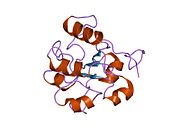Biology:DUSP6
 Generic protein structure example |
Dual specificity phosphatase 6 (DUSP6) is an enzyme that in humans is encoded by the DUSP6 gene.[1][2][3]
Function
The protein encoded by this gene is a member of the dual specificity protein phosphatase subfamily. These phosphatases inactivate their target kinases by dephosphorylating both the phosphoserine/threonine and phosphotyrosine residues. They negatively regulate members of the mitogen-activated protein (MAP) kinase superfamily (MAPK/ERK, SAPK/JNK, p38), which are associated with cellular proliferation and differentiation. Different members of the family of dual specificity phosphatases show distinct substrate specificities for various MAP kinases, different tissue distribution and subcellular localization, and different modes of inducibility of their expression by extracellular stimuli. This gene product inactivates ERK2, is expressed in a variety of tissues with the highest levels in heart and pancreas and, unlike most other members of this family, is localized in the cytoplasm. Two transcript variants encoding different isoforms have been found for this gene.[1] Upregulation of MKP-3 has been shown to alleviate chronic postoperative pain.[4][5]
Interactions
DUSP6 has been shown to interact with MAPK3.[6]
References
- ↑ 1.0 1.1 "Entrez Gene: DUSP6 dual specificity phosphatase 6". https://www.ncbi.nlm.nih.gov/sites/entrez?Db=gene&Cmd=ShowDetailView&TermToSearch=1848.
- ↑ "MKP-3, a novel cytosolic protein-tyrosine phosphatase that exemplifies a new class of mitogen-activated protein kinase phosphatase". The Journal of Biological Chemistry 271 (8): 4319–26. February 1996. doi:10.1074/jbc.271.8.4319. PMID 8626780.
- ↑ "Chromosomal localization of three human dual specificity phosphatase genes (DUSP4, DUSP6, and DUSP7)". Genomics 42 (3): 524–7. June 1997. doi:10.1006/geno.1997.4756. PMID 9205128.
- ↑ "Spinal mitogen-activated protein kinase phosphatase-3 (MKP-3) is necessary for the normal resolution of mechanical allodynia in a mouse model of acute postoperative pain". The Journal of Neuroscience 33 (43): 17182–7. October 2013. doi:10.1523/JNEUROSCI.5605-12.2013. PMID 24155322.
- ↑ "Mitogen-activated protein kinase phosphatase-3 (MKP-3) in the surgical wound is necessary for the resolution of postoperative pain in mice". Journal of Pain Research 10: 763–774. 2017-03-28. doi:10.2147/jpr.s129826. PMID 28405172.
- ↑ "The mitogen-activated protein kinase phosphatase-3 N-terminal noncatalytic region is responsible for tight substrate binding and enzymatic specificity". The Journal of Biological Chemistry 273 (15): 9323–9. April 1998. doi:10.1074/jbc.273.15.9323. PMID 9535927.
Further reading
- "Oligo-capping: a simple method to replace the cap structure of eukaryotic mRNAs with oligoribonucleotides". Gene 138 (1–2): 171–4. January 1994. doi:10.1016/0378-1119(94)90802-8. PMID 8125298.
- "Differential regulation of the MAP, SAP and RK/p38 kinases by Pyst1, a novel cytosolic dual-specificity phosphatase". The EMBO Journal 15 (14): 3621–32. July 1996. doi:10.1002/j.1460-2075.1996.tb00731.x. PMID 8670865.
- "Construction and characterization of a full length-enriched and a 5'-end-enriched cDNA library". Gene 200 (1–2): 149–56. October 1997. doi:10.1016/S0378-1119(97)00411-3. PMID 9373149.
- "Genomic analysis of DUSP6, a dual specificity MAP kinase phosphatase, in pancreatic cancer". Cytogenetics and Cell Genetics 82 (3–4): 156–9. 1999. doi:10.1159/000015091. PMID 9858808.
- "Crystal structure of the MAPK phosphatase Pyst1 catalytic domain and implications for regulated activation". Nature Structural Biology 6 (2): 174–81. February 1999. doi:10.1038/5861. PMID 10048930.
- "Angiotensin II-induced upregulation of MAP kinase phosphatase-3 mRNA levels mediates endothelial cell apoptosis". Basic Research in Cardiology 97 (1): 1–8. January 2002. doi:10.1007/s395-002-8381-2. PMID 11998972.
- "Potential tumor suppressive pathway involving DUSP6/MKP-3 in pancreatic cancer". The American Journal of Pathology 162 (6): 1807–15. June 2003. doi:10.1016/S0002-9440(10)64315-5. PMID 12759238.
- "Constitutive induction of p-Erk1/2 accompanied by reduced activities of protein phosphatases 1 and 2A and MKP3 due to reactive oxygen species during cellular senescence". The Journal of Biological Chemistry 278 (39): 37497–510. September 2003. doi:10.1074/jbc.M211739200. PMID 12840032.
- "Intramolecular dephosphorylation of ERK by MKP3". Biochemistry 42 (51): 15197–207. December 2003. doi:10.1021/bi035346b. PMID 14690430.
- "Both nuclear-cytoplasmic shuttling of the dual specificity phosphatase MKP-3 and its ability to anchor MAP kinase in the cytoplasm are mediated by a conserved nuclear export signal". The Journal of Biological Chemistry 279 (40): 41882–91. October 2004. doi:10.1074/jbc.M406720200. PMID 15269220.
- "Extracellular signal-regulated kinases phosphorylate mitogen-activated protein kinase phosphatase 3/DUSP6 at serines 159 and 197, two sites critical for its proteasomal degradation". Molecular and Cellular Biology 25 (2): 854–64. January 2005. doi:10.1128/MCB.25.2.854-864.2005. PMID 15632084.
- "Reactive oxygen species promote TNFalpha-induced death and sustained JNK activation by inhibiting MAP kinase phosphatases". Cell 120 (5): 649–61. March 2005. doi:10.1016/j.cell.2004.12.041. PMID 15766528.
- "Abrogation of DUSP6 by hypermethylation in human pancreatic cancer". Journal of Human Genetics 50 (4): 159–67. 2005. doi:10.1007/s10038-005-0235-y. PMID 15824892.
- "Distinct progression pathways involving the dysfunction of DUSP6/MKP-3 in pancreatic intraepithelial neoplasia and intraductal papillary-mucinous neoplasms of the pancreas". Modern Pathology 18 (8): 1034–42. August 2005. doi:10.1038/modpathol.3800383. PMID 15832194.
External links
- Overview of all the structural information available in the PDB for UniProt: Q16828 (Dual specificity protein phosphatase 6) at the PDBe-KB.
 |



